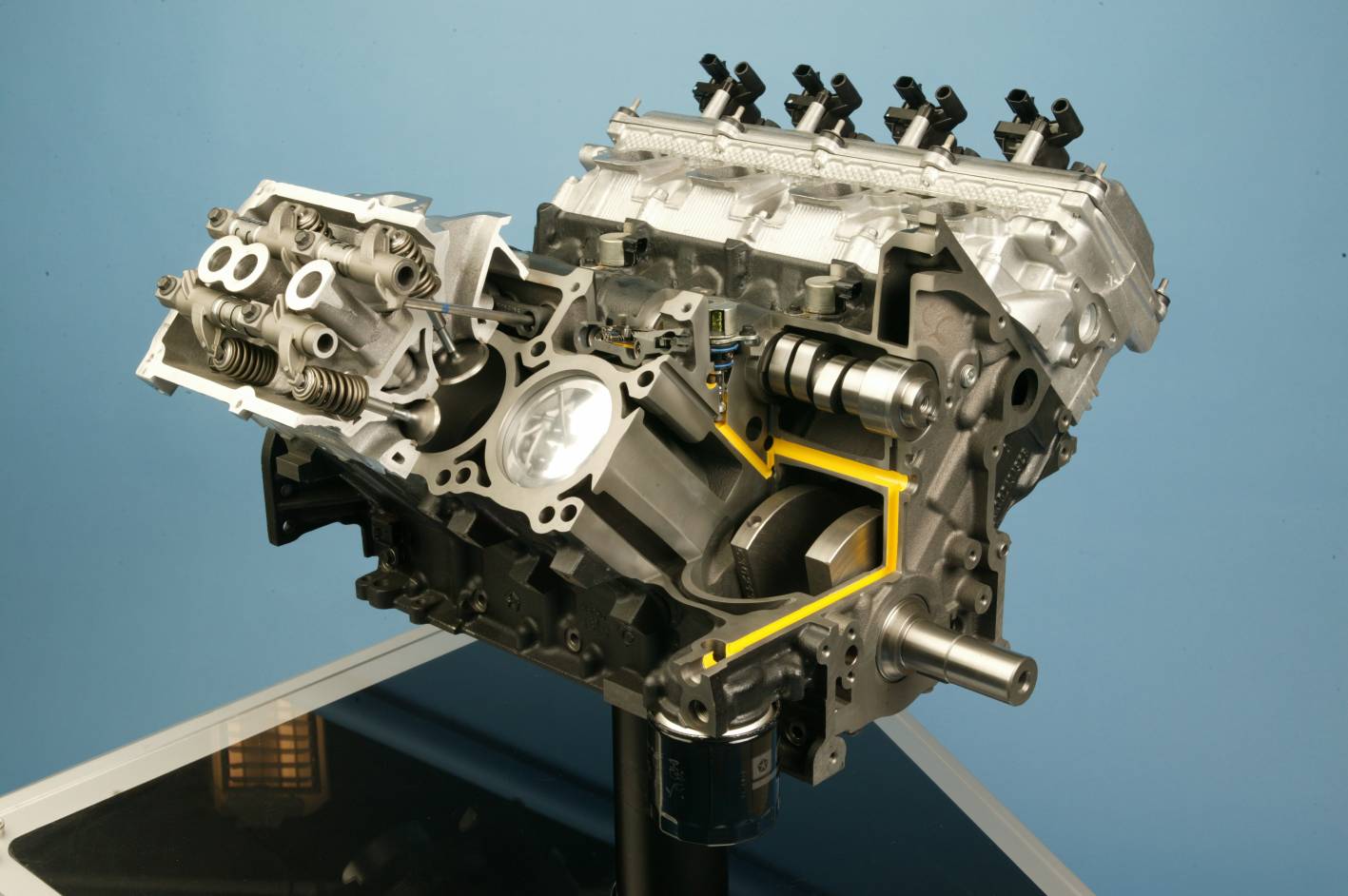The Mercedes-Benz M273 engine was a 90-degree V8 petrol engine that was first introduced in 2005 as an evolution of the M113 engine.
The M273 engine had an aluminium engine block with Silitec (Al-Si alloy) cast cylinder liners, five main bearings, an aluminium crankcase with reinforced bearing caps, a forged steel crankshaft, fracture-split 70MnVS4 forged connecting rods, sequential fuel injection, Bosch ME9 engine management with two micro-controllers, aluminium cylinder heads, double overhead camshafts (duplex chain-driven), independent intake and exhaust camshaft timing, four valves per cylinder, an aluminium-magnesium alloy variable intake manifold, tumble flaps in the intake channels, an oval hot-film air mass (HFM) meter, a compression ratio of 10.7:1.
While the 4663 cc M273 46 KE engine had 92.9 mm bores and an 86.0 mm stroke, the 5461 cc M 273 55 KE engine had 98.0 mm bores and a 90.5 mm stroke.
The M273 engine was superseded by the Mercedes-Benz M278 engine in 2010.
| Engine | Capacity | Peak power | Peak torque | Model | Years |
|---|---|---|---|---|---|
| M273 46 KE | 4663 cc | 250 kW at 6000 rpm | 460 Nm at 2700-5000 rpm | X164 GL 450 | 2006-12 |
| W221 S 450 | 2006-10 | ||||
| M273 55 KE | 5461 cc | 285 kW at 6000 rpm | 530 Nm at 2800-4800 rpm | W164 ML 500 | 2007-11 |
| X164 GL 500 | 2006-12 | ||||
| A207 E 500, C207 E 500 |
2009-11 | ||||
| A209 CLK 500, C209 CLK 500 |
2006-10 | ||||
| W211 E 500 | 2006-09 | ||||
| W212 E 500 | 2009-11 | ||||
| C219 CLS 500 | 2006-10 | ||||
| W221 S 500 | 2005-11 | ||||
| R230 SL 500 | 2006-11 | ||||
| W251 R 500 | 2007-13 | ||||
| W463 G 500 | 2008-15 |
M273 engine: worn timing chain guide gear
In May 2011, Mercedes-Benz issued service bulletin LI03.30-P-050027 for Mercedes-Benz vehicles with M273 V8 engines which:
- Had serial numbers prior to 2739..30 088611; and,
- Were manufactured prior to September 2006.
In these vehicles, a worn guide gear for the timing chain could cause the positioning of the camshafts in the right cylinder bank to be impaired (relative to the crankshaft). According to the service bulletin, this wear of the balancer shaft sprocket could cause the following symptoms:
- Illumination of the check engine light; and,
- Diagnostic trouble codes (DTCs) 1200 or 1208 stored in the ME-SFI control unit.
From September 2006 production, a harder material was used for the timing chain guide wheel.
For the M273 V8 engine, the repair procedure is as follows:
- Remove the right front camshaft adjuster cover;
- Check the timing chain guide wheel for wear using a flexible borescope;
- If worn, replace the guide gear (part number A273 050 06 05) of the chain drive;
- Replace the chain tensioner;
- Change engine oil and filter;
- Drive with engine at high load and rpm for at least 20 km;
- Change engine oil and filter once more; and,
- Replace the camshaft adjustment solenoids.
M273 engine: cam plug oil leak
Mercedes-Benz M272 V6 and M273 V8 engines that were produced prior to June 2008 may experience oil leaks (or ‘seepage’) from the round plastic expansion plugs (‘cam plugs’) on the back of the cylinder heads. There were two different size cam plugs:
- Part number A000 998 55 90: two small expansion plugs (approximately 2.5 cm diameter); and,
- Part number A000 998 56 90: one large small expansion plug (for engines without vacuum pump).
To fix,the existing plugs were to be removed, the opening cleaned and new plugs fitted; no sealer was to be used in the installation of the new plugs.In June2008, new cam plugs that were not susceptible to oil leaks were phased into production.
M272 V6 and M273 V8 engines: VIM actuator cam breakage
For Mercedes-Benz M272 and M273 V8 engines, the plastic actuator cam in the variable intake manifold (VIM) is susceptible to failure. Symptoms of a broken actuator cam include:
- Rough idle;
- A loss of power (particularly at low and mid-range engine speeds);
- Illumination of the check engine lights; and,
- Diagnostic Trouble Codes (DTCs) such as P2004, P2005, P2006, P2187 and P2189.
Due to the venting of oil from the PCV (positive crankcase ventilation) system, carbon deposits can accumulate on the swirl flaps inside the variable intake manifold. These carbon deposits increase the resistance on the plastic actuator cam and this can cause it to break. Other parts can also fail as a result, including the swirl flaps, the actuator mounting arms and the vacuum diaphragms.
AustralianCar.Reviews understands that the original equipment supplier for the intake manifold is Pierberg and that Mercedes-Benz’s repair involves replacing the entire intake manifold since they do not supply replacement actuator cams. However, eEuroparts.com sell intake manifold repair kits that replace the plastic actuator cam with a metal component and can be used for DIY repairs. However, the intake manifold also needs to be cleaned as part of any repair. For further information about this problem, please see:
- eEuroparts.com: Fixing Mercedes-Benz Intake Manifold Woes; and,
- eEuroparts.com: Mercedes-Benz Intake Manifold Repair DIY.


